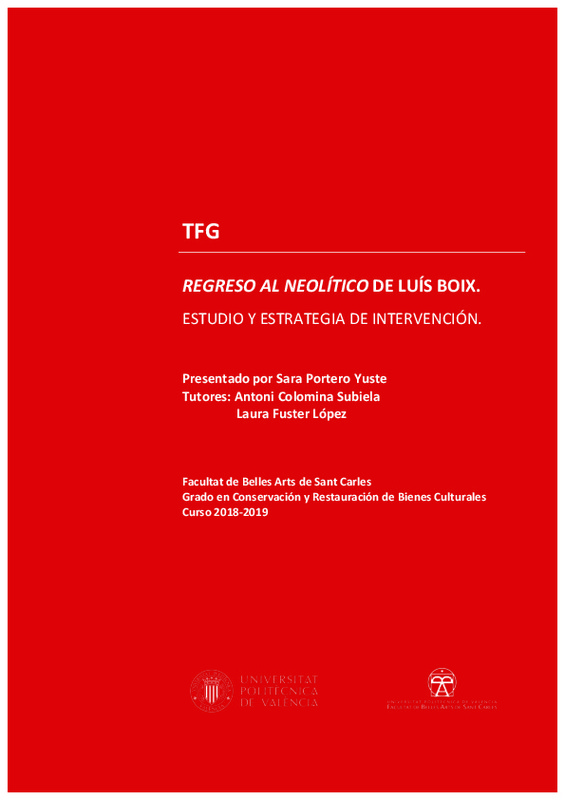JavaScript is disabled for your browser. Some features of this site may not work without it.
Buscar en RiuNet
Listar
Mi cuenta
Estadísticas
Ayuda RiuNet
Admin. UPV
Regreso al Neolítico de Luís Boix. Estudio y estrategia de intervención
Mostrar el registro sencillo del ítem
Ficheros en el ítem
| dc.contributor.advisor | Fuster López, Laura
|
es_ES |
| dc.contributor.advisor | Colomina Subiela, Antoni
|
es_ES |
| dc.contributor.author | Portero Yuste, Sara
|
es_ES |
| dc.date.accessioned | 2019-11-07T17:24:28Z | |
| dc.date.available | 2019-11-07T17:24:28Z | |
| dc.date.created | 2019-09-10 | |
| dc.date.issued | 2019-11-07 | es_ES |
| dc.identifier.uri | http://hdl.handle.net/10251/130477 | |
| dc.description.abstract | [EN] The festival of the fallas is a manifestation of the Valencian popular culture, coming from the evolution of the bonfires of solstice and that it receives special notoriety from the 17th century. Over the years, the celebration of this festival has been transformed and adapted to the social peculiarities of each epoch. Thus, at a symbolic level, it has been manipulated at various times by political censorship. In the same way that in the field of festive activity were incorporated new-proposals such as children's creations or acts such as L'Ofrena or L'Indult del Foc, so consolidated in our day. With regard to the creative industry fallera and the office of the artist fallero, construction and reading of the ninot as satirical element protagonist in the scene has evolved with regard to the use of techniques and procedures. In this way, the materials used as support, meet the premises of organic and fuels, such as for example the wax, wood, cardboard or expanded polystyrene, which have been determined by the professional needs and business of the artists. With the purpose of approaching this technical evolution and material is performed the study and the intervention on one ninot of cardboard-stone of the artist José Boix, pardoned in 1964 and that is conserved in the Museu de l'Artista Faller of Valencia. The work has a historical study of the piece, which helps your contextualization within the discourse that has determined the evolution of the creation fallera. With regard to its intervention, attends especially altered the colour of the work produced by the continued application of repainting and the deposit of superficial dirt. | es_ES |
| dc.description.abstract | [ES] La fiesta de las fallas es una manifestación de la cultura popular valenciana, procedente de la evolución de las hogueras de solsticio y que cobra especial notoriedad a partir del siglo XVII. Con los años, la celebración de esta fiesta se ha ido trasformando y adaptando a las particularidades sociales de cada época. Así pues, a nivel simbólico, se ha visto manipulada en varios momentos por la censura política, del mismo modo que en el ámbito de la actividad festiva se fueron incorporando nuevas propuestas, como las creaciones infantiles o actos como l¿Ofrena o l¿Indult del foc, tan consolidados en nuestros días. Por lo referente a la industria creativa fallera y el oficio de artista fallero, la construcción y lectura del ninot como elemento satírico protagonista en la escena ha evolucionado en cuanto a la utilización de técnicas y procedimientos. De este modo, los materiales utilizados como soporte, cumplen las premisas de orgánicos y combustibles, como por ejemplo la cera, la madera, el cartón o el poliestireno expandido, que han venido determinados por las necesidades profesionales y empresariales de los artistas. Con la finalidad de aproximarse a esta evolución técnica y material se realiza el estudio y la intervención sobre un ninot de cartón-piedra del artista José Boix, indultado en 1964 y que se conserva en el Museu de l¿Artista Faller de Valencia. El trabajo cuenta con un estudio histórico de la pieza, que ayuda a su contextualización dentro del discurso que ha determinado la evolución de la creación fallera. Por lo que respecta a su intervención, atiende especialmente a la alteración cromática de la obra, producida por la aplicación continuada de repintes y el depósito de suciedad superficial. | es_ES |
| dc.language | Español | es_ES |
| dc.publisher | Universitat Politècnica de València | es_ES |
| dc.rights | Reconocimiento (by) | es_ES |
| dc.subject | arte efímero | es_ES |
| dc.subject | cartón-piedra | es_ES |
| dc.subject | ninot | es_ES |
| dc.subject | José Boix | es_ES |
| dc.subject | restauración | es_ES |
| dc.subject | fallas | es_ES |
| dc.subject | ephemera-art | es_ES |
| dc.subject | paper | es_ES |
| dc.subject | Luís Boix | es_ES |
| dc.subject | conservation | es_ES |
| dc.subject.classification | PINTURA | es_ES |
| dc.subject.other | Grado en Conservación y Restauración de Bienes Culturales-Grau en Conservació i Restauració de Béns Culturals | es_ES |
| dc.title | Regreso al Neolítico de Luís Boix. Estudio y estrategia de intervención | es_ES |
| dc.type | Proyecto/Trabajo fin de carrera/grado | es_ES |
| dc.rights.accessRights | Abierto | es_ES |
| dc.contributor.affiliation | Universitat Politècnica de València. Departamento de Conservación y Restauración de Bienes Culturales - Departament de Conservació i Restauració de Béns Culturals | es_ES |
| dc.contributor.affiliation | Universitat Politècnica de València. Facultad de Bellas Artes - Facultat de Belles Arts | es_ES |
| dc.contributor.affiliation | Universitat Politècnica de València. Instituto Universitario de Restauración del Patrimonio - Institut Universitari de Restauració del Patrimoni | es_ES |
| dc.description.bibliographicCitation | Portero Yuste, S. (2019). Regreso al Neolítico de Luís Boix. Estudio y estrategia de intervención. http://hdl.handle.net/10251/130477 | es_ES |
| dc.description.accrualMethod | TFGM | es_ES |
| dc.relation.pasarela | TFGM\106666 | es_ES |
Este ítem aparece en la(s) siguiente(s) colección(ones)
-
BBAA - Trabajos académicos [5086]
Facultad de Bellas Artes






